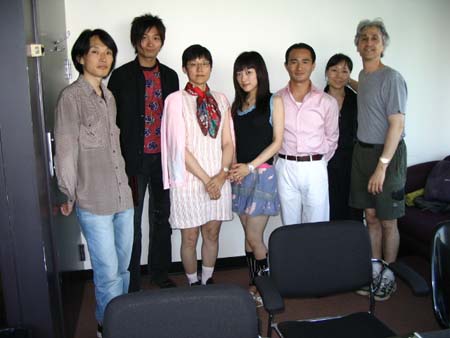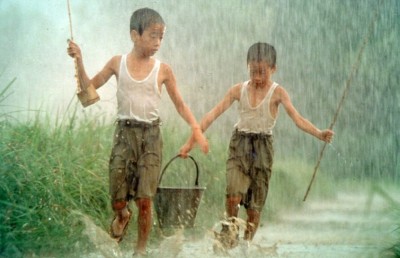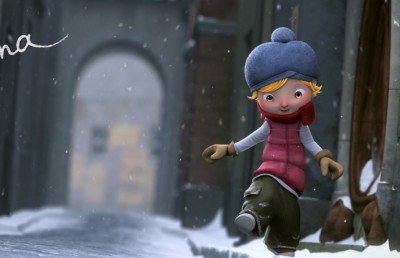The Bottled Fool Interview
An Interview with Shinya Zoki
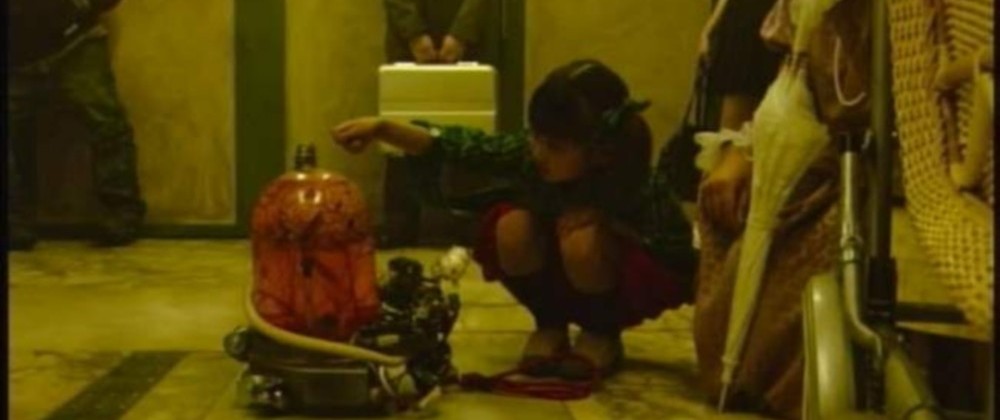
As I said in my most recent Fantasia International Film festival report, the director of Bottled Fool, Hiroki Yamaguchi, is a good bet to become the next big thing out of Japan. After making a prize winning short in 1999 at the age of 21 (Shinya Zoki/Midnight Viscera) he soon completed his first feature film in the same year, Hateshinai tameiki (1999). At the age of 26 he is touring festivals with his latest film, Bottled Fool, which he completed at age 23. Bottled Fool is a low budget film, part horror, part science-fiction, which thrives on its self-imposed limitations (it is set mainly in one location, a large elevator) and is brimming with fascinating ideas, visual, sonic, and thematic. Yamaguchi begins with an often used science fiction premise of a geographically stratified society (underground/above ground). This plot, often used as a form of geopolitics, goes as far back as H.G. Well’s The Time Machine and Fritz Lang’s Metropolis, right on through to Planet of the Apes and Bladerunner. In Yamaguchi’s young hands the premise maintains the geopolitical edge but is modernized by manga-styled visuals (inventive camera angles, varied color textures, and intense violence).
In the film’s premise people travel vertically in elevators to various city floor ‘levels.’ The neo-futuristic film begins with a pre-credit television report of explosions at “Level 138.” The scene cuts to the interior of a police station, where a police detective is interrogating someone about the explosion, and asks the person to “recount the story from the beginning.” The first post-credit scene, in effect the start of a long flashback, takes place in an arched city embankment littered with homeless people and social workers handing out food. Amid the chaos a high school girl dressed in traditional school uniform, named Luchino (Luchino Fujisaki), is stopped by a police officer for suspicion of smoking, which is an illegal act. With the help of an older salary man she manages to escape from the police, in the process dropping her cigarette only inches from a suspicious looking spill (which is what will cause the explosion). Luchino enters an elevator at “Level 138,” which is where the majority of the film will take place. The passengers in the elevator are Luchino, a teenage boy with dark glasses continually listening to his walkman, a mother and her closely guarded baby, a nervous-looking scientist (Saisho Ikuma), and a female employee who operates the elevator. They are joined at floor Level 99, the Penal Colony, by two dangerous convicts being escorted to the prison level (“Level 0”) by two police officers. The two psychotic inmates overpower and murder the policeman and begin to violently terrorize the passengers. One of the escaped inmates is an especially dangerous and psychotic serial rapist-murderer played with joyful glee by Keisuke Urushizaki, whose performance should go down as one of the most terrifying psychos in cinema history.

After much abuse the victims turn against their tormenters and violently murder the two convicts. Near the end of their ordeal, the two teenagers, who we learn are telepaths, telepathically communicate the knowledge that the scientist is an anti-government terrorist carrying a dangerous biological weapon. In a violent rage, partly triggered by a flashback to when she killed her father, Luchino kills the scientist. She is arrested and submitted to shock therapy. In the final scene Luchino is an inmate being escorted to the prison level. The policeman escorts her to the prison level (“Level 0”) and tells her, “Now you go your way. You’ll never come back to our world.” We expect to see a terrifying penal environment. Luchino climbs her way up a staircase and through a manhole. For the film’s final image, the camera dollies back quickly from Luchino to reveal a brief flash of what looks like a Tokyo cityscape at night.
The film is many things, including a study of how people behave in moments of prolonged confinement and duress, but the simple premise is enlivened by clever and unexpected character and narrative revelations. As the director reveals in this interview, the overriding theme in the film is ‘preconception’ and how people can be easily fooled by them. Accordingly, none of the characters can be trusted to be who they appear to be on the surface. The film’s non-linear structure allows breathing space from the singular and claustrophobic setting by cutting away to police interrogation scenes that are set after the elevator event, and shots representing Luchino’s subjective visions. The film is so full of invention that even the film’s final enigmatic shot leaves the audience intellectually and emotionally ‘winded.’
This interview took place a few days after the second screening of Bottled Fool at the 2004 Fantasia International Film Festival. Involved in the interview are the director Hiroki Yamaguchi, the lead actress Luchino Fujisaki, who plays Luchino, and Saisho Ikuma, who plays the scientist-terrorist. Also present but not involved in the interview are Noriyuki Waki, who played the police officer who tries to arrest Luchino in the opening scene, and Mijeong Lee, programmer for the Fantasia International Film Festival. The translator is Tomoko Okabe. (Donato Totaro)
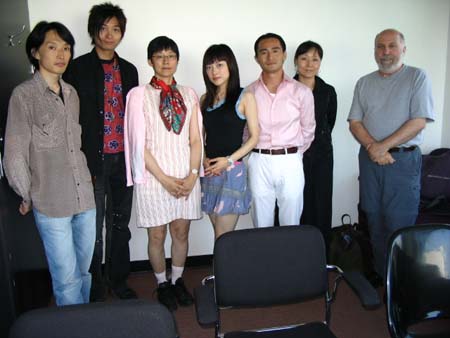
Offscreen: What was the budget and shooting schedule for Bottled Fool
Hiroki Yamaguchi: I have strict orders from my producer not to disclose the budget! But as you can guess it is a surprisingly low budget. Just to give you an indication if it were an ordinary budget it would be the cost only for the art direction.
Offscreen: When did you first start shooting and when did it end?
Hiroki Yamaguchi: The span was two months but in reality it was one and a half months because there was an interruption.
Offscreen: What was done in 2000 and what was done in 2004?
Hiroki Yamaguchi: We started preproduction in October 2000 but we actually started shooting in March 2001 and finished in May 2001.
Offscreen: You had mentioned that it started as a student film or that there were crew members who were students. Was it conceived as a student film and then made outside of school?
Hiroki Yamaguchi: The movie I made when I was 19 years old was with some friends who wanted to learn about film making but the film was made outside of the University. It started as an independent student made film but outside of the University.
Offscreen: So were all the cast and crew working on a feature for the first time?
Hiroki Yamaguchi: There are some differences between the film I made when I was 19 years old and this one which I made when I was 23 years old, but there were not many professionals in either case. They were mainly volunteers and students. The only professional crew members were myself and the director of photography, Hikaru Yasuda. In fact the director of photography had worked on a number of big budget movies, but other than that the crew was mainly students and volunteers.
Offscreen: In total how many made up the cast and crew?
Hiroki Yamaguchi: About 20 in total.
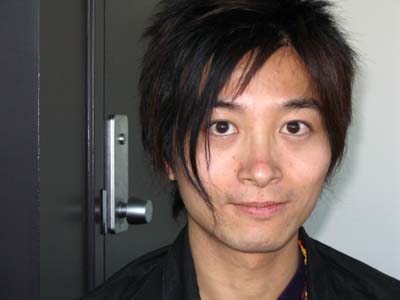
Offscreen: Maybe each actor can give us their background and how they came to this film?
Luchino Fujisaki: This is my first professional movie. I have worked in a few independent movies but this is my first major role.
Offscreen: How would you describe your character? How did you prepare for your role? You play a very withdrawn character which then has to come out and do some very violent things.
Luchino Fujisaki: I wanted to focus on acting with my eyes because I wanted to show how strong the character was even sitting down hunched in the corner of the elevator. I want to project this strength by showing the sparkle in her eyes. I also lost quite a bit of weight for the role.
Offscreen: We get the sense that your character is very small physically but she still carries a very strong presence in the film.
Luchino Fujisaki: I went to the gym every day to strengthen myself physically.
Offscreen: As well, you wear a girl’s school uniform, which these days in Japan is quite complex in the sense of reflecting purity yet you also have a lot of characters now in school girl uniforms who are tough characters. One example is Takashi Miike’s Fudoh: The Next Generation (1997) which was shown in Fantasia (1997) and actually was the first time a Miike film had shown in North America. In Fudoh the schoolgirl is a killer. So there you have irony in the use of the girl’s school uniform and toughness, like with your character.
Offscreen: The actor who played the serial killer, Keisuke Urushizaki, was very good. He is one of the scariest villains I’ve ever seen in a movie. I was wondering whether you were ever afraid of him during the actual film making?
Luchino Fujisaki: As a person he was very shy, with a low voice, a very quiet and well-behaved man. Not scary at all, but when he started shooting he just switched into this other gear.
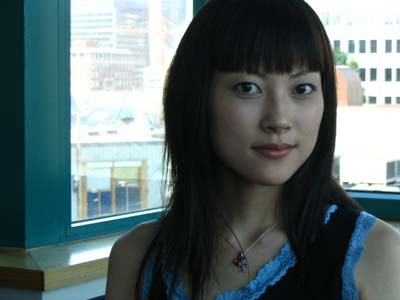
Saisho Ikuma: I did not have any movie experience before this film. When I was 28 years old I had an exhibit at a Japanese museum. Around this time I joined a workshop in Japan studying the New York Actor’s Studio method and I stayed there for five years. Since then my activities have included television, drama, movies, and theater. I’ve worked in comedy roles before but for this film I am a microbiologist, a totally different role. For this character I wanted to make sure that the nervousness of the character came through, which is different from the original character and from myself. I am much more of an emotional and wild person and a scientist is very rational and cold. I did my own research before the film and read several biographies of scientists. I wore glasses and a beard to help give the physical look of a scientist and I lost about 15 pounds to look lean and thin.
Offscreen: So you really used the method style to become the doctor!
Saisho Ikuma: For the bloody sequences in the elevator after my character killed the convict the director encouraged the actors to do some improvisation to come up with something different from the original script.
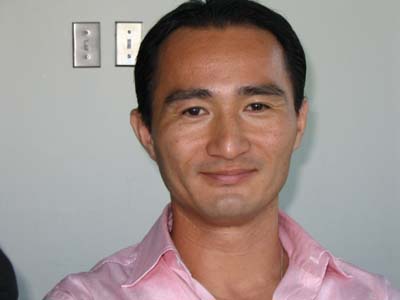
Offscreen: Was the script shot in sequence?
Hiroki Yamaguchi: Well for the bloody sequences in the elevator we had to shoot the first part and then the last part because with all the blood spattering it would have been difficult and then we went in sequence. After the killing sequences we had to clean the blood and paint the elevator white. You may remember one of the flashbacks with Luchino and the scientist where the elevator was all white.
Offscreen: It is hard to tell from a specific projection exactly what the film is supposed to look like but it seemed to me to be either very bright, as in the white sequences, or very dark, and not much in between. I think the projector for the first night’s screening was very good. Were you happy with the way the film looked projected on the second night?
Hiroki Yamaguchi: The elevator scenes were OK, as I would imagine them, but some of the other darker scenes that you have described were a bit too dark. And some of the white scenes weren’t quite bright enough to create that contrast.
Offscreen: I was very impressed with the film’s visual style and I thought that some of the dark scenes would have been too dark so that corresponds to my interpretation of that particular screening (the second screening). In any case, for such a low budget film it looks really great and has very strong visual consistency.
Hiroki Yamaguchi: The contrast was precisely my point because I realize the limitations of video but wanted to ensure that it looked like film so I asked a lot of help in that respect from the director of photography and luckily he had a lot of technique to achieve the look I wanted.
Offscreen: What kind of a digital camera did you use?
Hiroki Yamaguchi: A Panasonic DVC-Pro.
Offscreen: Since we asked the actors about their background I would like to ask the same of the director.
Hiroki Yamaguchi: I actually wanted to become a comic book writer since I was 13 or 14 years old. I never studied film in University or any other formal context. Even though I wanted to be a comic book writer from a young age I never finished a single comic. At the end of high school when I was about 18 I saw films at a local autumn film festival and I thought, maybe I could do better. That was the first time that I really thought about making movies. Instead of applying to study film I applied to study drawing and art. But I did not get into that department either. And then when I got to University I started making some films with other student friends.
Offscreen: Which University?
Hiroki Yamaguchi: I applied at the Art University but was not accepted so I studied literature at the Ritsumeikan University in Kyoto. But this became a stepping stone for me to become involved in student activities.
Offscreen: For your information the two best known Canadian filmmakers both studied literature and not film, David Cronenberg and Atom Egoyan!
Offscreen: The sets were very interesting and I was wondering which were actual locations and which were sets? Like for example, the opening in the underground or underground subway. Where was that shot? And I’m thinking particularly of the elevator. Was that something you built with three walls to help you move and bring in equipment or was that a real elevator that you shot in?
Hiroki Yamaguchi: The elevator is a set that I built with four walls but the walls are detachable so that we could bring in equipment and take them out as we needed. We built the elevator all by ourselves with discarded wood and boards we found at the scrap yard.
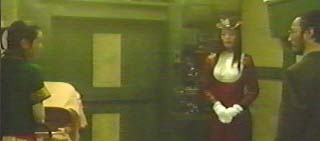
Offscreen: But the arched set in the beginning was that some kind of bridge or tunnel?
Hiroki Yamaguchi: The inspiration for that came from a photo collection called Japan Underground. I saw a picture of the area and became interested in it visually and I searched out its location, which was in a suburb of Tokyo.
Offscreen: Well it is a great looking opening to the film.
Hiroki Yamaguchi: Actually that location has been very popular among movie directors. The TV show Ultraman also used it. And a film that was shown here last year at the Montreal Film Festival, Water Under the Bridge by Shohei Imamura, also used it.
Offscreen: I was wondering about the English translation of the film, Bottled Fool or Gusher No Binds Me.
Tomoko Okabe: The “Gusher No Binds Me” is written in Katakana. In Japanese “Gusher” means two things, it really means the fool, or idiot but at the same time the word “Gusha” is an onomatopoeia meaning to break things. We use it in Japanese to describe things that are going to be broken. The “Binds Me” is just a bottle and Yamaguchi preferred bottle because you can see inside a bottle, like you can see inside the room. So the translation of “Gusher No Binds Me” is “Bottled Fool.”
Offscreen: I think the film is full of ideas, there is the political espionage part of it, the telepathy, but the idea that struck me as the most intriguing is this underground subculture, which is very common in science-fiction. Metropolis, The Time Machine, The Planet of the Apes and many other science-fiction films have this dual structure society where the rich live above ground and the poor below ground. What intrigued you about the idea of an underground subculture?
Hiroki Yamaguchi: Comic books are the number one source of my inspiration. My favorite animation film is Akira and I love a manga called Blane. This idea of a multilayered society came from Blane. The work is very well-known overseas. There is an artist and writer in France named Enki Bilal who also loves Blane.
Offscreen: Yes, he has a film playing at Fantasia which is very popular, Immortel (2004).
Offscreen: The use of numbers in terms of floor numbers is quite interesting, like the elevator floors numbered 0 to 138. There are two ways of thinking of the numbers. If you go into a normal building the higher numbers go up but when you see the film at the end you are at zero and you get this very brief shot of a cityscape at night which looks like Tokyo. So we have the reverse where the higher numbers go down below ground and the lower numbers rise upwards. Also, was there anything to the strange names associated with the numbers? Where did you come up with those names?
Hiroki Yamaguchi: The names are just a collection of words in terms of interesting sounds, favored things, or words in reverse or in different combinations of sounds. I tested the names so that they would sound as strange as possible and futuristic as well.
Offscreen: On the floor numbers everything is higher than 100 which makes us appreciate how deep this underground is. What we don’t think about until the end is that it is actually minus, so it is floor number -128 or -130, so that when you finally get to the last shot above ground it is a very impressive effect. I would like you to talk about the meaning of that last shot. To me the film without that shot is a different film but once you’ve seen that last shot you begin to think about everything in a different way.
Hiroki Yamaguchi: To back up, the idea for this movie started before when I won the Grand Prix at Japan’s Indie Movie Festival in 2000 [the film was Shinya Zoki/Midnight Viscera]. The budget for that was about $4,000 Canadian, just on the one sequence of the elevator and the eight people enclosed in it. After I won the Grand prize I got some funding and began to develop the idea in the direction of my favorite thing, which is science-fiction. I did not think about the underground until later. At first I just had the elevator and the idea of enclosure but at some point I thought maybe it would be a very interesting idea if it all happened underground. One of the major themes in the movie is preconception and so I wanted to deal with two things: how telepathy has a limit because the character played by Luchino does not see that the baby was actually dead. This can be seen as one example of preconception. And the other idea was of course the underground society as opposed to the above ground society.
Offscreen: You are also playing with the audience’s preconceptions as well because at the end we believe that the prisoners are being taken to prison, or the end of the world as it is described, and it ends up being a city, as if they are being let loose in the city. Is that meant to be a joke or a twist ending, or is it meant to be a comment on living in contemporary modern society being like a prison? I also would think that everyone in Japan would understand the last shot as being Tokyo, is that right?
Hiroki Yamaguchi: Yes. And yes it is an ironic joke to have the prisoners released in a modern society.
Tomoko Okabe: Actually one of the discussions I had in other interviews is that for Western audiences it is easier to accept clear endings, but for Japanese audiences, in director Yamaguchi’s view, what is given in the film is just enough. If he were to show more clues then that would be too much.
Offscreen: Yes it is nice to have that ambiguity at the end. It makes it a richer text.
Offscreen: The short film that you showed before Bottled Fool also had this twist where the ending subverts our preconceptions because the human characters end up being cockroaches.
Hiroki Yamaguchi: I’m very happy that you mention that point because it is one of the main purposes of making the movie, to make the audiences think about the film afterwards and going through the experience of preconception and realize that they were wrong.
Offscreen: I would like to ask the actors about this idea of preconception and irony. With the exception of the Luchino character, all the characters seem to change and they turn bad, but Luchino seems very direct. In terms of preconceptions each of the characters is hiding something which we will eventually learn. For example, we find out that the scientist is this political terrorist. The elevator lady acts very much like a robot until the end when she became more emotional. Whereas the Luchino character is the opposite, she begins very withdrawn and at the end she kills and becomes more emotional. Which goes back to what director Hiroki Yamaguchi is saying about preconceptions, how everyone changes.
I’ll give you an example of the irony I am thinking of and it deals with the use of cigarettes. I used to be a very heavy smoker. I don’t smoke anymore but I am not anti-smoking and I understand it is very popular among young people, so that young people watching this movie would identify with Luchino because she is being stopped from smoking. They would identify with her rather than the police who are stopping her from smoking. But there is irony in that because, where we might think that smoking is bad, it is associated with this energetic, rebellious character which might make it seem like a positive thing as well. This is probably why when the Luchino character kills her father, I think there must therefore be something wrong with the father.
Luchino Fujisaki: My character is very pure and simple. In my view the character is very cynical toward adulthood. The adult characters are sort of contaminated in the process of becoming an adult. My character thinks the adults have a foolish attitude and behavior.
Offscreen: That is what I thought too which is interesting because, as I said, Luchino kills her father. I also saw a gender theme involved in that because men in the film are predators and so she is fighting against that and also because there is the suggestion that her father could also be a predator.
Luchino Fujisaki: The Japanese audiences did not pick up on your idea of gender conflict but rather the idea of preconceptions being wrong.
Offscreen: Anyway, the reason I brought up the smoking is that Luchino is going to be very happy at the end of the film when she gets to “Level 0” because she can smoke in Tokyo. It is not illegal!
Offscreen: I also thought the film was interesting as an analysis of human behavior because there have been a lot of psychological studies done on captivity and people who have been put into a closed environment, whether the military or prison, or in close quarters, where people begin to behave differently or the way they might normally behave if there were no social rules. Were you interested in these character dynamics as an analysis of human behavior? I am particularly thinking of their reaction to the violence. When the prisoners come into the elevator and begin to behave violently the young male teenager sits in the corner and does not seem to care. There is a sense of indifference, where the people do not try to help at all. They each react to the violence in a different way which relates to another question regarding the audience. Well it is two questions. How have audiences reacted to the violence, which is very intense in certain moments? And is that part of a subtext with the characters in the film reacting to violence and then the audience reacting to the same violence? I guess I am trying to make a connection between the characters in the film who are watching the violence and how they react or do not react, and the cinema audience watching the violence. I mention this also because generally I find there is a different attitude to violence in popular culture in Japan than in the West. It is much more accepted in Japanese popular culture. In the West I think it is much more controversial and tied to questions of morality.
Hiroki Yamaguchi: I wanted everybody in the audience to identify somehow with a character whoever it might be, and I wanted to represent many elements of society. I’ve had some interesting feedback from viewers in Japan. One person said that while he was watching the movie he felt it was completely detached from his environment, like a totally different world, but in the end he saw it as a modern society that he was also living in. He was able to associate himself with a teenager, so the narrative was not all completely fiction because he thought it was close to his reality. I was very happy to hear that. And also in the scene where the elevator conductor lady is attacked by the rape/serial killer convict, the two other men try not to be involved in any way. This is typical behavior for men in Japan: they will try to rescue themselves only and not become involved with others.
Offscreen: So it is not necessarily a generational thing since it is also the young teenager who does not do anything to help as well as the slightly older doctor? It is gender rather than generational.
Offscreen (At this point Mijeong Lee, the Fantasia film festival programmer interjects a question): What I found interesting was the way you structure the story, with the police man in the present, interviewing the young man, who then describes each character one by one. I thought his was a little bit like Rashomon (Akira Kurosawa, 1950), where we get varying views of the same event from the point of view of different characters. In this case the event is the big explosion at the beginning of the film started by a cigarette. They try to investigate why this explosion happened and then get into the details and the personal characters inside the elevator. Did the script always have that structure?
Hiroki Yamaguchi: There is no direct inspiration from the film Rashomon since I have not seen the movie. But the structure of the movie developed at the editing stage.
Offscreen Well what you have in the film that you don’t have in the book that Rashomon was taken from is that each character has a different interpretation of what actually happened and the remarkable thing about that film was that it was the first film to actually show something that was not true. Here we are, an audience believing this story and then we get another version of the story and it is different, and yet another, until we have to wonder what we believe in. So there is the introduction of the idea that there is no such thing as an objective reality, that reality is subjective.
Hiroki Yamaguchi: I wanted to show this idea because I have seen many people who are influenced by one person’s reality or preconception.
Offscreen: Rashomon was the first Japanese film to be accepted in the West. In the West it was regarded as being very Japanese and in Japan it was regarded as being very Western. I think because it was such an unusual film it was regarded as foreign by whoever was looking at it!
Offscreen: Bottled Fool does not have a specific time setting, even though it feels like a science-fiction film. Does it matter whether we see it as being set in the future or in contemporary times?
Hiroki Yamaguchi: It is a contemporary film.
Offscreen: A gendai-geki!
Offscreen: When you think of Tokyo and Japanese culture it is very modern, with cutting edge technology but the underground society represented in the film is very low-tech. We even see the police detective’s secretary using a typewriter. It is almost a satire on modern society. Of course mixing high and low tech is also a convention of science-fiction.
Hiroki Yamaguchi: I am really into small details. A long time ago in the 12th or 13th century people were repelled from society for religious reasons or other reasons. They started to escape from the pressures of society and began to form their own underground communities, detached from society. They began to be completely cut off from the connections and developments of society in all manners. That was the sort of background idea I adopted.
Offscreen: There’s one scene which is very interesting stylistically because time seems to come to a stop. It is the scene where the image turns to black-and-white and you have a man and some paper money floating in the air in what looks like a bullet time effect, which we have seen everywhere since The Matrix. I’m just curious to know how that effect was achieved. I know in 35 mm you generally need to have a lot of cameras that are lined up with each taking selected frames which are then collaged together in a series of still-like images. Was it a function of the digital camera?
Hiroki Yamaguchi: Of course The Matrix had an impact on my movie. I wanted to show that the effect is also possible on a low-budget with one camera. It was acted in slow motion! The floating bills were actually hanging from the ceiling and the criminal that was shot was also hanging from the ceiling and the camera moved around them.
Offscreen: Well it was very effective and I think it was clever to use silence because it added to the idea of stopped time or dead time. When you have little money you are sometimes forced to be creative. So maybe you don’t want a big budget movie! If someone gave you a bunch of money maybe you would not be as creative (laughter all round). Or your professional actors would not want to be suspended in air on wires!
Offscreen would like to thank director Hiroki Yamaguchi, actors Luchino Fujisaki, Saisho Ikuma, and Noriyuki Waki. A very special thanks goes to Tomoko Okabe who gave graciously of her time as translator and Mijeong Lee who helped make this interview possible.
